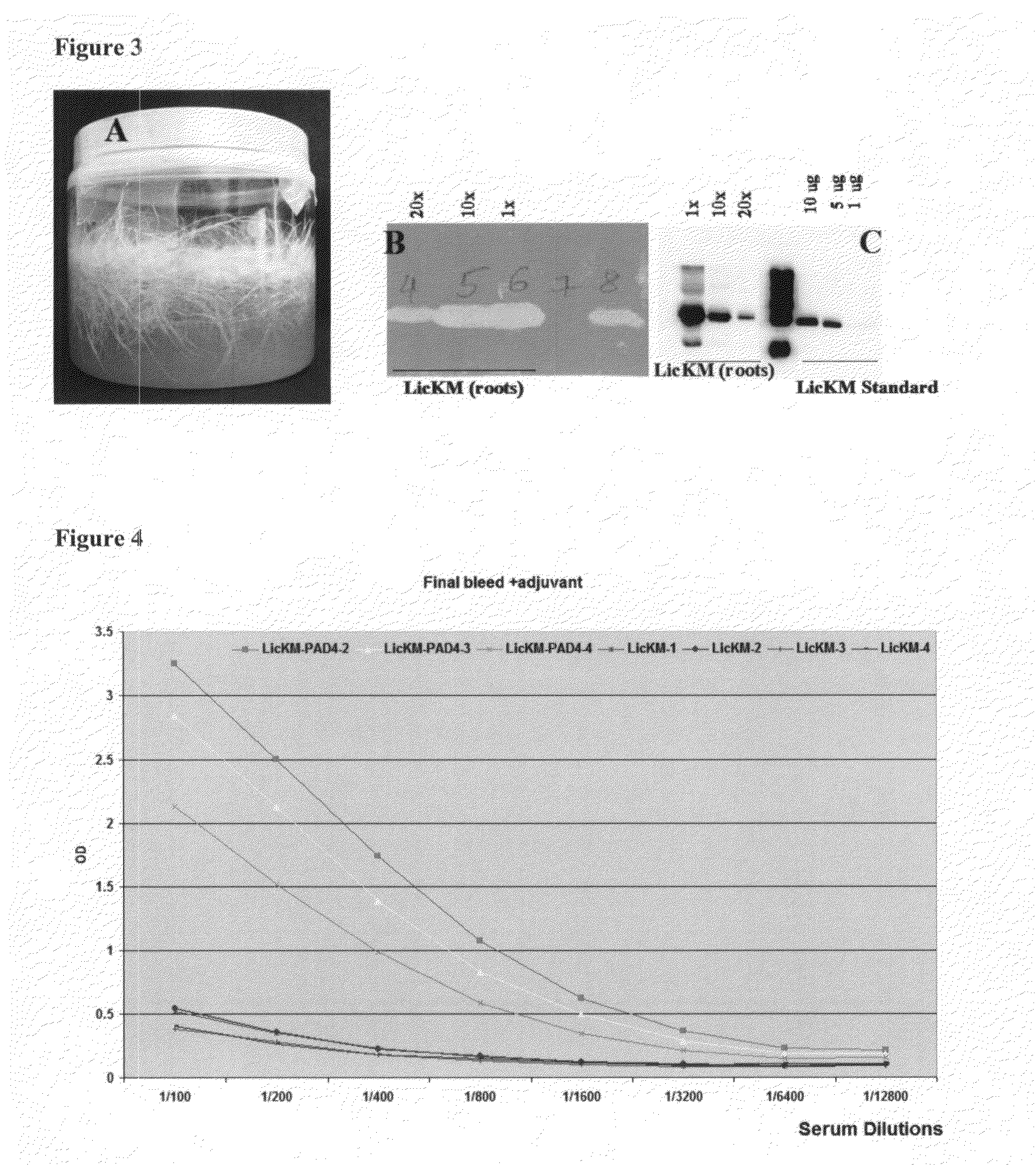Bacillus anthracis antigens, vaccine compositions, and related methods
a technology of anthrax and antigens, applied in the field of bacillus anthracis antigens and vaccine compositions, can solve the problems of cell death, inability to definitively diagnose anthrax infection, and inability to provide resuscitation car
- Summary
- Abstract
- Description
- Claims
- Application Information
AI Technical Summary
Benefits of technology
Problems solved by technology
Method used
Image
Examples
example 1
Generation of Vaccine Candidate Constructs
[0180]Generation of Antigen Sequences from B. anthracis
[0181]Nucleotide sequence encoding 148 amino acids (residues 617 to 764) of domain four of B. anthracis PA was synthesized and confirmed as being correct. Produced nucleic acid was digested with restriction endonucleases BglII and HindIII, sites for which had been engineered onto either end of sequence encoding domain four. The resulting DNA fragment was fused in frame to sequence encoding an engineered thermostable carrier molecule.
[0182]Nucleotide and amino acid sequence of domain 4 of PA (amino acid residues 592-731 of the mature PA polypeptide, SEQ ID NO.: 3; SEQ ID NO.: 4, respectively).
SEQ ID NO.: 3:AGATCTAGAGATAAGAGATTTCATTATGATAGAAACAACATTGCTGTTGGAGCTGATGAATCTGTTGTTAAGGAGGCTCATAGAGAGGTTATTAACTCTTCTACTGAGGGACTTTTGCTTAACATTGATAAGGATATTAGAAAGATTCTTTCTGGATATATTGTTGAGATTGAGGATACTGAGGGACTTAAGGAGGTTATTAACGATAGATATGATATGCTTAACATTTCTTCTCTTAGACAAGATGGAAAGACTTTTATTGATTTTAAGAAGTATAACGATAAGT...
example 2
Generation of Vaccine Candidate Antigen Vectors
[0188]Target antigen constructs LicKM-PAD4 or LicKM-LF were individually subcloned into the chosen viral vector (D4). D4 is a TMV-based construct in which a foreign gene to be expressed (e.g., target antigen (e.g., LicKM-PAD4) replaces the coat protein (CP) gene of TMV. The virus retains the TMV 126 / 183 kDa gene, the movement protein (MP) gene, and the CP subgenomic mRNA promoter (sgp), which extends into the CP open reading frame (ORF). The start codon for CP has been mutated. The virus lacks CP and therefore cannot move throughout the host plant via phloem. However, cell-to-cell movement of viral infection remains functional, and the virus can move slowly to the upper leaves in this manner. A multiple cloning site (PacI-PmeI-AgeI-XhoI) has been engineered at the end of sgp for expression of foreign genes, and is followed by the TMV 3′ non-translated region (NTR). The T7 RNA polymerase promoter is fused to the 5′ NTR to make in vitro t...
example 3
Generation of Plants and Antigen Production
Clonal Root and Clonal Root Line Generation
[0189]Generation of clonal roots and clonal root lines is depicted in FIG. 11. Fully expended leaves of P. hybrida grown in greenhouse were surface sterilized for 6 minutes with 10% bleach (Clorox®) and washed several times with sterile distilled water. Surface sterilized leaves were cut into 1 cm2 pieces. They were placed on a surface of preculture medium which is sucrose-free MS (Murashige et al., 1962, Physiologia Plantarum 15:473) medium with 1 mg / l of NAA (naphthalene acetic acid) and 0.2 mg / l of BA (benzyl adenine) and 0.8% of agar. Leaf pieces were kept on preculture medium for 4-5 days. A. rhizogenes strain A4 with the engineered pBID4 expressing PAD4 was grown to an OD600 of 0.8-1. Bacterial cells were pelleted and resuspended in MS-1 medium (MS salts, 1% glucose, 10 mM MES, pH 5.5) to a final OD600 of 0.1. In order to induce virulence in the bacterium, acetosyringone hormone was added to ...
PUM
| Property | Measurement | Unit |
|---|---|---|
| Thermal stability | aaaaa | aaaaa |
Abstract
Description
Claims
Application Information
 Login to View More
Login to View More - R&D
- Intellectual Property
- Life Sciences
- Materials
- Tech Scout
- Unparalleled Data Quality
- Higher Quality Content
- 60% Fewer Hallucinations
Browse by: Latest US Patents, China's latest patents, Technical Efficacy Thesaurus, Application Domain, Technology Topic, Popular Technical Reports.
© 2025 PatSnap. All rights reserved.Legal|Privacy policy|Modern Slavery Act Transparency Statement|Sitemap|About US| Contact US: help@patsnap.com



